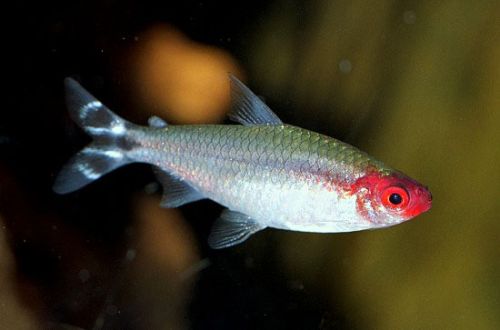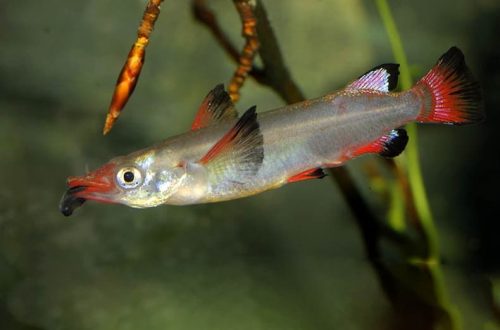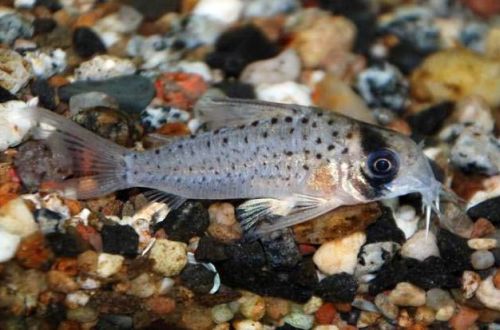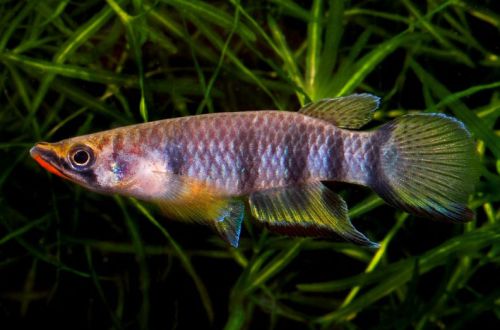
Red-nosed Tetra
The Red-nosed Tetra or Bleer’s Tetra, scientific name Hemigrammus bleheri, belongs to the Characidae family. A beautiful recognizable fish, popular with aquarists worldwide due to its easy availability and peaceful nature. Tetra is widely represented both in specialized retail chains and in private breeders.

Habitat
It lives in the upper tributaries of the Amazon River (South America), which are distinguished by a high content of organic matter, from which the water acquires a dark brownish color. Prefers to stay in dimly lit places with plenty of natural cover. Currently, all fish presented in pet stores are bred in captivity, so there are no problems with adaptation.
Brief information:
- The volume of the aquarium – from 70 liters.
- Temperature – 24-28°C
- Value pH — 5.0–7.0
- Water hardness – soft (1-12 dGH)
- Substrate type – any dark
- Lighting – subdued
- Brackish water – no
- Water movement is weak
- The size of the fish is up to 5 cm.
- Food – any food
- Temperament – peaceful
- Keeping in a flock of at least 6-10 individuals
Description
A miniature slender fish with large scales, reaches a length of no more than 5 cm. A distinctive feature is that the head has a red pigmentation, the color of the body is silvery with a lighter belly. The tail is striped with horizontal black and white strokes.
Outwardly, it resembles a closely related species of Rhodostomus, which has an identical color, but which can be distinguished by a smaller amount of red pigment, limited to the head region and not extending beyond the gill cover.
The confusion is added by the presence of another independent species, called the False Rhodostomus, which also has a similar body color and is distinguished by the presence of an elongated black stroke on the caudal peduncle.
Food
An omnivorous species, with pleasure consumes dry, frozen and live food. In order for the fish to receive a balanced diet to dry food (flakes or granules), it is recommended to add protein foods (bloodworm, daphnia). Make sure the food particles are small enough to fit in your mouth.
Maintenance and care
Tetra Bleer imposes special conditions on the quality and purity of water, it must be acidic and soft, with a minimum content of third-party contaminants. It is advisable to install a filter with a peat-based filter element, which tends to acidify water. It is also necessary to ensure good aeration, for this place several sprayers around the aquarium. Other necessary equipment: a heater and a low power lighting system, as the fish prefer subdued light.
The design uses dense thickets of plants planted in groups along the walls of the aquarium so that there is a free area for swimming in the central part. River sand soil with decorative elements in the form of snags, roots, etc. You can put a few dry leaves on the bottom, they contribute to coloring the water in a light brown color. Leaves should be replaced every two weeks.
Social behavior
Peaceful, friendly and shy schooling fish, prefer the company of the same peaceful and calm species of small size. Content in a flock of at least 7-10 individuals. Activity outside the aquarium, noise, loud noises, as well as overly active and restless neighbor fish will provoke Tetrs to seek shelter, escape from possible danger, this can lead to stress and, as a result, a decrease in immunity.
Breeding / breeding
Successful breeding is possible only in a separate tank, this will save the juveniles, since the fish are prone to eating their eggs. A spawning aquarium with a volume of 40 liters is quite sufficient. Equipment, if possible, should be similar to the main aquarium. The design uses sandy soil and plants with small leaves.
By including protein foods in your daily diet, you can stimulate the start of the mating season. In the wild, an abundance of food is the signal for the start of the breeding season. After two weeks of intensive feeding, the fish will be ready for relocation to a separate tank, but favorable conditions should be created in advance for this.
During scheduled cleaning in the main aquarium, when part of the water is drained and fresh water is added, the “old” water can be poured into the spawning aquarium and also supplemented with fresh water. In this case, the water parameters in both reservoirs will become almost identical and the fish will not feel any serious changes during the resettlement.
The male and female (she will be noticeably larger due to the swollen abdomen) are placed in a separate spawning tank. After some time, the female will lay her eggs either directly on the ground, or attach them to the leaves of plants. The male immediately fertilizes the eggs. When the whole process is completed, the parents are returned back, the fry will appear on the second day, and after 4 days they will begin to move freely around the aquarium, from this moment it is necessary to feed. Feed micro food, Artemia nauplii.
Diseases
The Red-nosed Tetra is prone to skin diseases if kept in unsuitable water. Does not tolerate hard water, this begins osmotic shock and rapid death. Read more about symptoms and treatments in the Aquarium Fish Diseases section.





